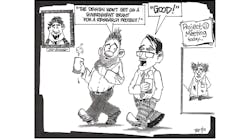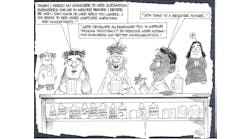This Control Talk column appeared in the August 2021 print edition of Control. To read more Control Talk columns click here or read the Control Talk blog here.
Greg: There are many interactions and interruptions when more than one flow affects a controlled variable. The solutions often cited in the literature are quite complicated, posing design and maintenance problems. Alex Smith, senior process control engineer at a refinery, opens our eyes to a straightforward practical solution for loops to get along and play nicely together.
Alex, what are some of the issues?
Alex: Two situations that almost all control practitioners encounter are the cases where 1) two manipulated variables (MVs) are regulating the same controlled variable (CV) and where 2) two MVs are regulating a very closely coupled set of CVs.
In the first scenario, it’s common to see a split-range controller used, but that has the limitation of always sticking one of the MVs in saturation (fully opened or fully closed). Also, a split-range controller usually performs its handoff (passing control from one MV to the other) right in the center of the design level of operation. Control valves, the most common type of final element in the process industry, lose their linearity when they get below about 10% open or above about 90% open. So, in many cases, split-range handoff involves one unpredictable control valve more than 90% open giving control to another unpredictable control valve less than 10% open in the center of the operating region.
In the latter case involving closely coupled CVs, there are myriad techniques that have been developed to eliminate control-loop coupling; however, most of them are irrelevant to the control practitioner. There is a fair amount of academic literature on some of these model-based techniques, like relative gain arrays and controller diagonalization, but these techniques have severe limitations. The relative gain array can only help you make the best lemonade out of sour lemons, with no guarantee that the lemonade is any good. Diagonalization techniques produce elegant solutions that are difficult to implement, highly susceptible to model error, and nearly impossible to document on an industrial control system.
Greg: What's your solution?
Alex: Several years ago, I encountered a very unsophisticated solution to these problems: the position controller. I mean to use the word “unsophisticated” in the most positive way possible because there are no mathematical formalisms, no matrix algebra, no singular value decomposition, and no weighting matrices. There’s just a simple change of variables for one controller.
The fundamental concept is to designate one MV as the big knob, and the other as the little knob. The little knob gets to control the original CV under normal operations. So, if you're converting two flow controllers to a position controller architecture, the little knob remains a flow controller. The big knob becomes a position controller for the little knob. The MV is the big knob valve output, the CV is the position of the little knob valve, and the setpoint is 50% (or wherever you want the little knob to sit during normal operation; I usually pick 50% because that gives you maximum flexibility up and down).
Greg: What are design and tuning considerations?
Alex: Determining which MV is the big knob and which is the small knob depends on your objectives, but most of the time, it’s best to make the big knob the MV that has a greater steady-state effect on the CV (or coupled pair of CVs). Also, consider designating the MV with less transport delay as the little knob because it will act on a much shorter time scale than the big knob.
Configuring this scheme involves a little retagging and retuning, but it’s fairly non-invasive for a live system. The major change is designating the little knob’s output as the CV for the big knob controller. As long as the position controller is open-loop during the configuration change, few issues arise.
The major complication with this scheme arises from initialization and fallback design requirements. Different vendors have different methods for ensuring bump-less initialization and fallback, so it's difficult to be proscriptive about the initialization design. If the little knob is out of service, the big knob needs to stop being a position controller and start directly regulating the CV with a new set of tuning parameters. When the little knob controller comes back into service, the big knob controller needs to return (probably manually) to a position controller without bumping the process.
Tuning this scheme is fairly straightforward. I usually use internal model control (IMC) tuning rules for first-order-plus-dead-time (FOPDT) process models, so I step-test the little knob first while the big knob is open-loop, tune the little knob aggressively, then step-test the big knob while the little knob loop is closed-loop.
Greg: What's a common example involving one controlled variable and two manipulated flows?
Alex: Adding a second control valve in parallel to increase flow capacity is commonly done. The control configuration for this would normally involve adding a split-range, total-flow controller that scales the first valve’s range from 0-50% controller output, and the second valve’s range from 50-100% output. The primary issue with this architecture is that the area of greatest instability is in the center of the range, as mentioned above. A position controller setup would have the smaller of the two valves controlling the total flow through a flow controller, while the larger of the two valves controls the position of the smaller valve, eliminating the split range.
The unstable handoff region still exists, but it occurs at the bottom of the range instead of at the center. If two parallel valves are sized the same, and the position controller setpoint is 50%, the instability occurs at 25% of the total flow capacity (the big knob begins to open when the little knob exceeds 50%).
Greg: Another use of a position controller is to extend valve rangeability by having a small valve directly manipulated by the process controller and the position controller manipulating the large valve to keep the small valve in a good throttle position (e.g., 50%). This reduces the discontinuity and nonlinearity from backlash and stiction that's greatest near the closed position by eliminating split-range control, and enables more precise regulation of flow for most upsets by the process controller manipulating the smaller valve. The fine adjustment by the smaller valve is more precise because the flow from a given percentage resolution limit or deadband is less, and the percent itself can be less for a smaller valve. Adaptive gain in a position controller can reduce unnecessary movement of the big valve, allowing the small valve to do most of the work. For more on eliminating split-range control, see the Control Talk column, “The best valve position control.”
What is an example where there are two process variables to be controlled?
Alex: Simultaneous header pressure and flow control involves mixing two streams, where the control valve in stream one (V1) is used to control the downstream header’s total flow (F) and the control valve in stream two (V2) is used to control the downstream header’s pressure (P). These two variables could be highly coupled if the streams are liquid or a gas with a low compressibility. The use of a position controller to decouple these two variables requires that one variable be used to manipulate the other, or that one of the variables is “given up.” In the first of three options, P cascades to F which controls V1, while V2 position controls off of V1. In the second option, P controls V2 and the position controller controls F based on V2’s position. F controls V1. In the third option, give up on F or P, and position control the given-up variable’s valve.
There are obviously more permutations of this arrangement, but I’m leaving out any scenario that involves using flow as a cascade master or switching which valve is controlling P or F.
As you can guess from this example, the strength of this scheme’s ability to decouple two variables is related to the lack of time delay between the variables. Differences in open-loop time constant are not concerning though because the decoupling is partially handled through a cascade architecture, which benefits from some closed-loop time constant separation by tuning.
Greg: There are some enhancements that can be used to help the position controller. Feedforward action for large disturbances in position controller can help the valve manipulated by the process controller from getting too close to the wide open or shut position. Directional move suppression (DMS), where the position controller is used for optimization, can provide a smooth, gradual approach to optimum and a fast getaway for disruptive disturbances. External-reset feedback (ERF) can enable tuning the position controller for the worst-case disturbance and the use of DMS for optimization without the need for retuning. ERF can also reduce oscillations from backlash, stiction and slow stroking times. The many examples of position controllers for optimization are noted in the Control article “Don’t overlook PID in APC.” The “ISA 5.9 Technical Report on PID Algorithms and Performance” covers ERF and many other PID features. There is also an upcoming series of columns on the ISA 5.9 Technical Report in the works.
10. You need to remember all you learned in university courses on control theory
9. You need a professor to explain the solution
8. The math requires Z-Transforms and Nyquist plots
7. The solution only exists in literature
6. Maintenance techs take early retirement after seeing design
5. The design is a PhD Thesis
4. The design takes more than a day to configure
3. The tuning requires matrix manipulations
2. Operators are totally confused
1. The solution assumes valves have an immediate, smooth, and precise response




